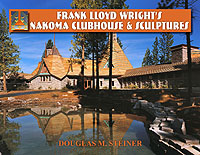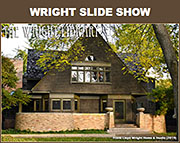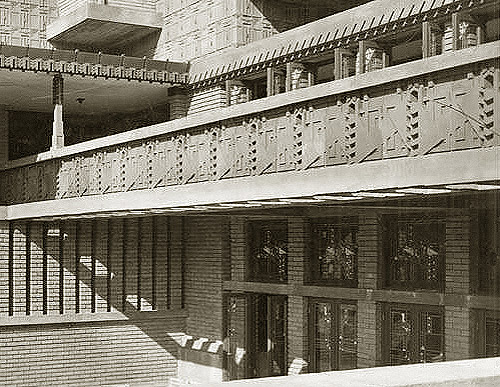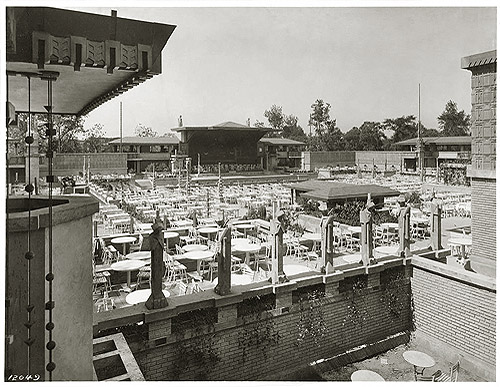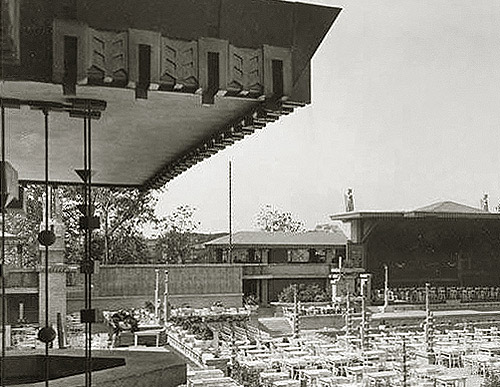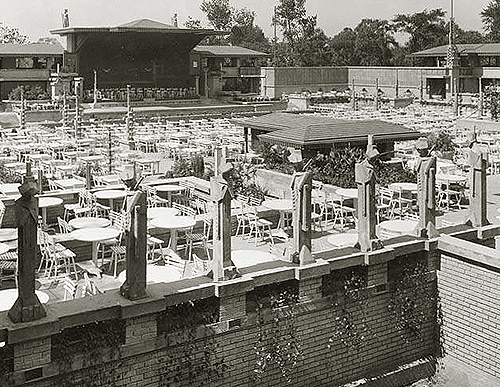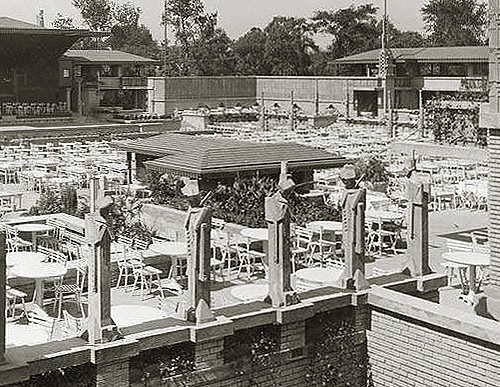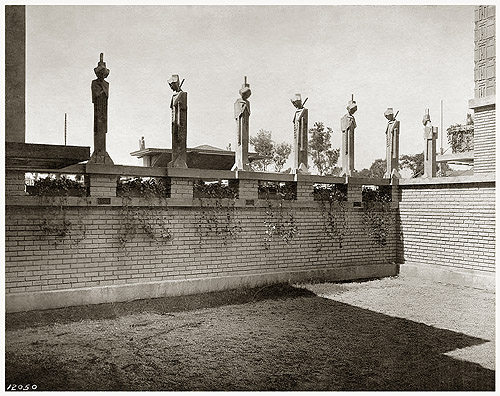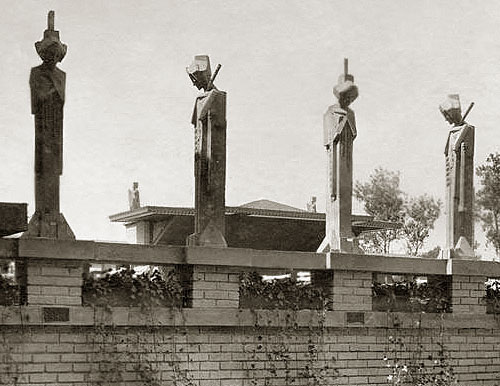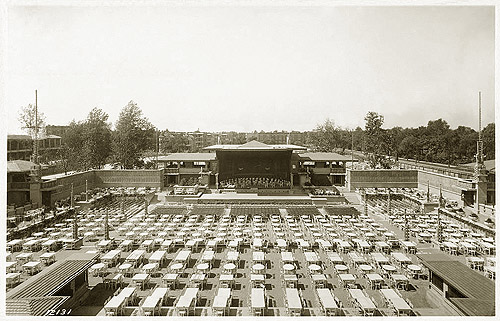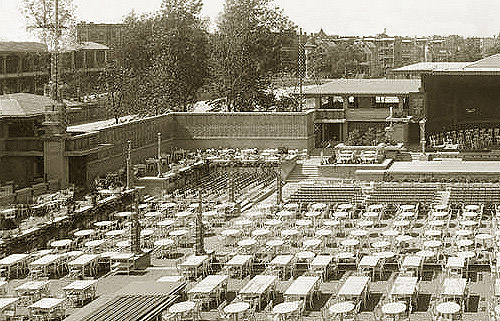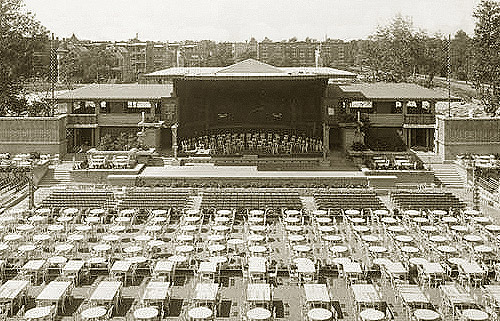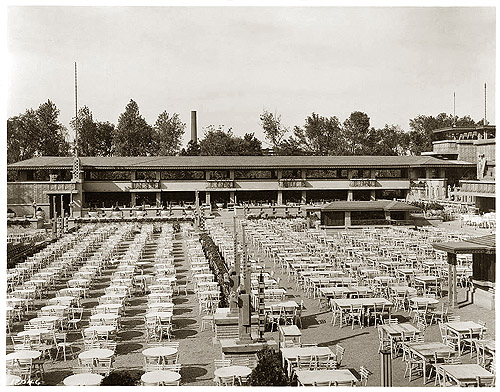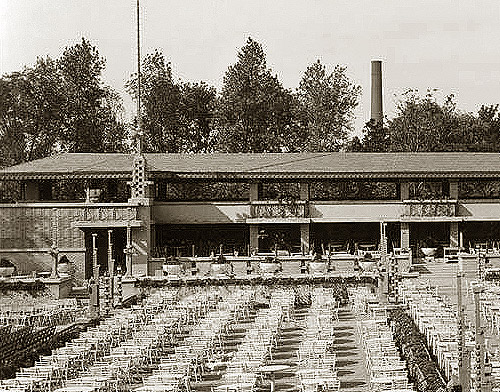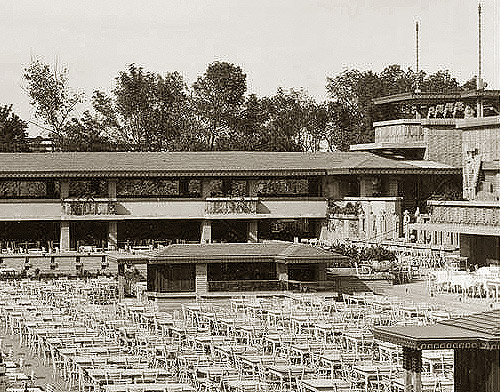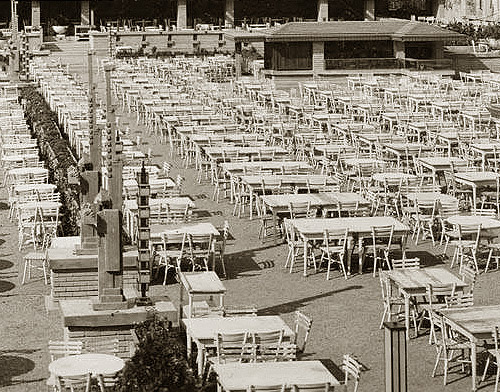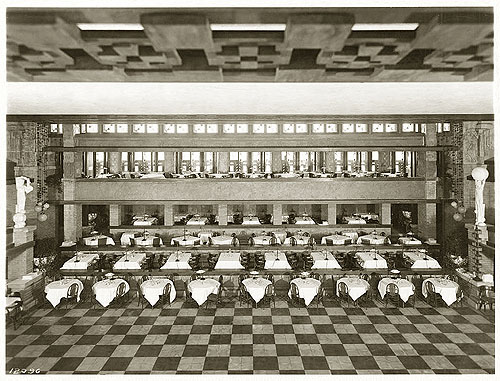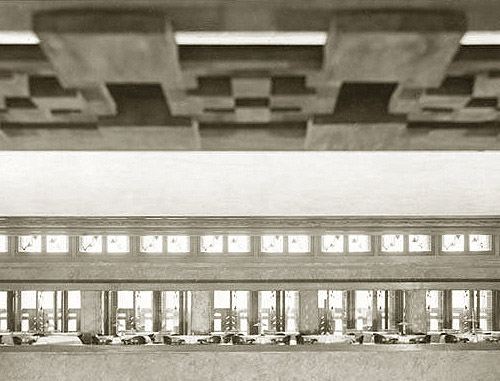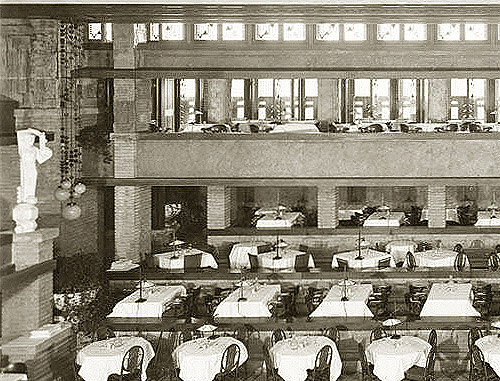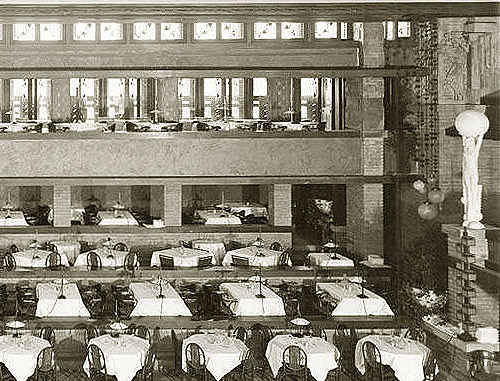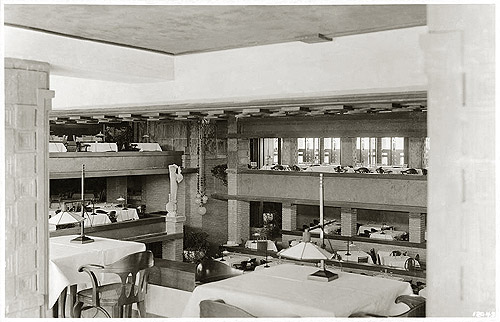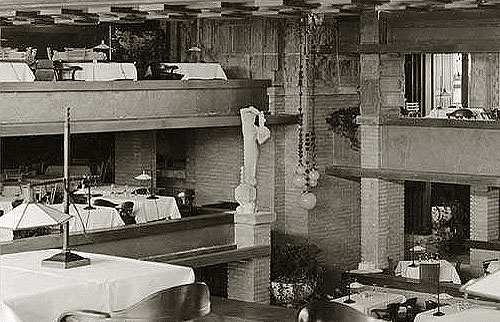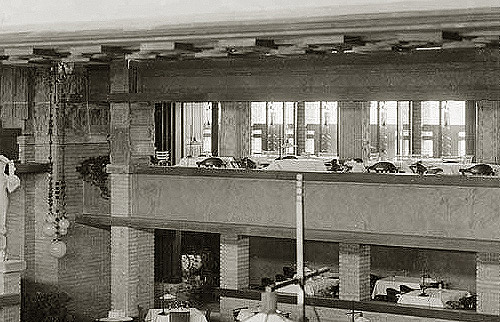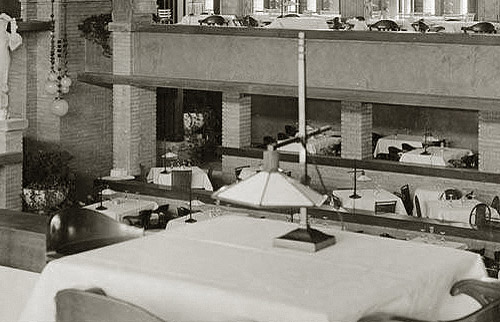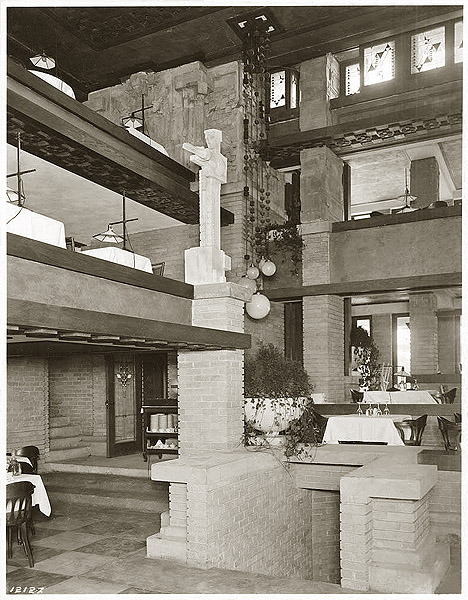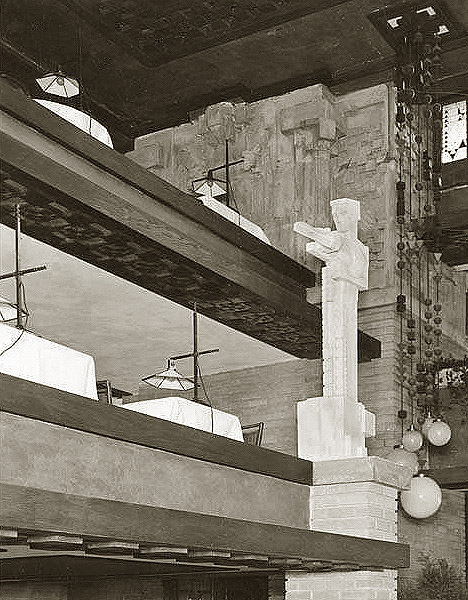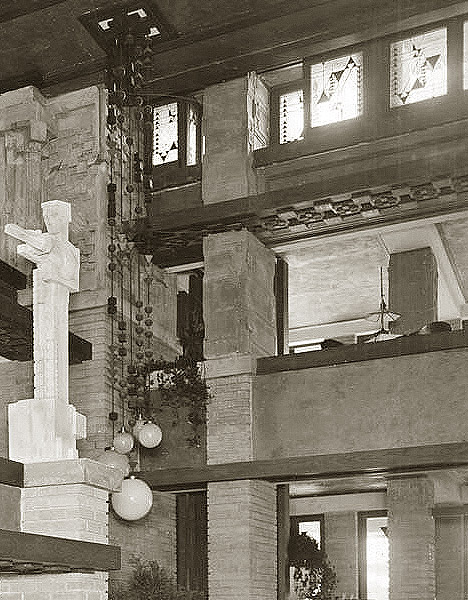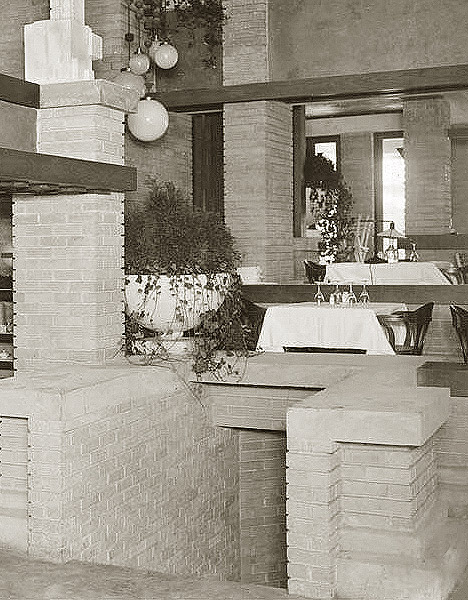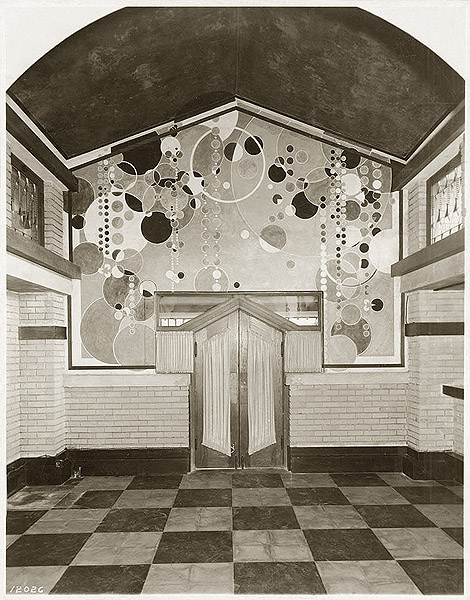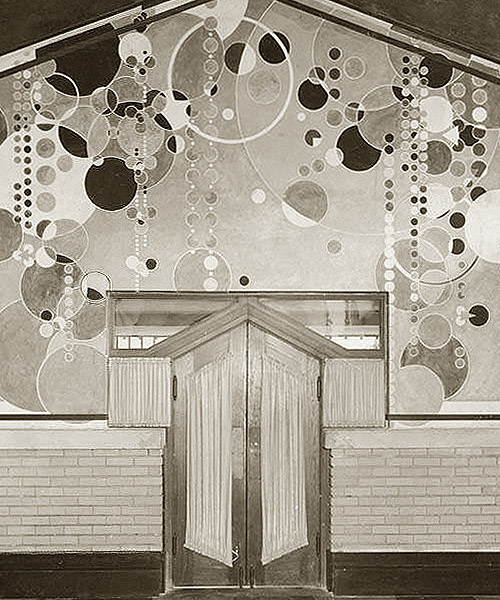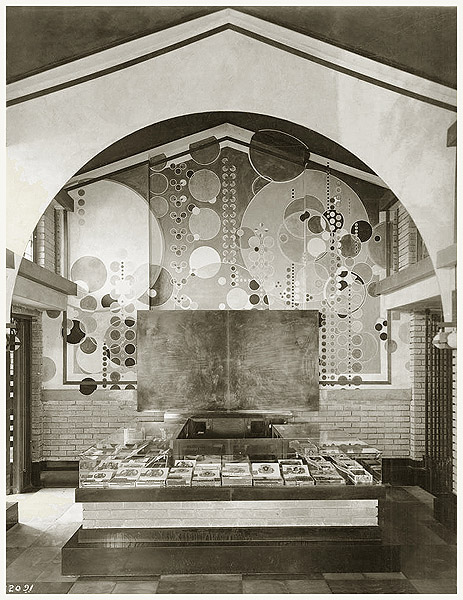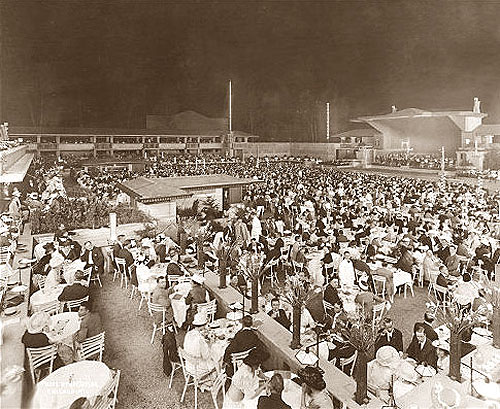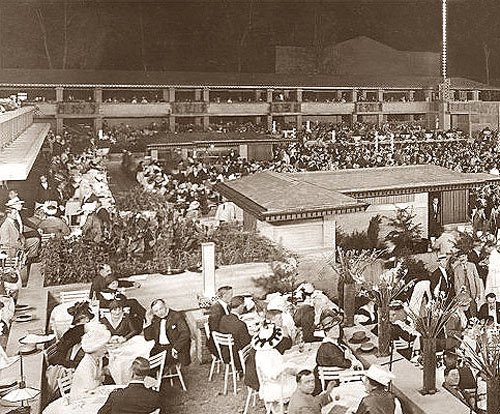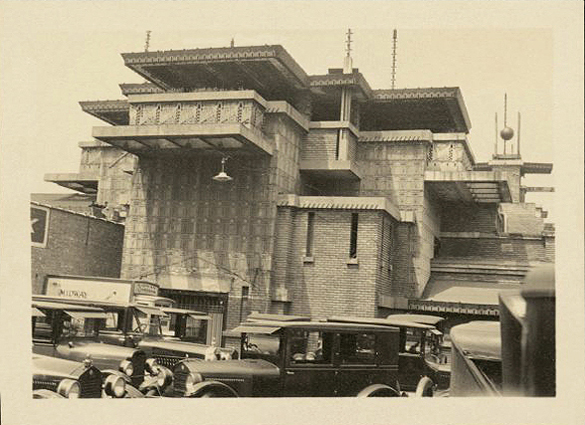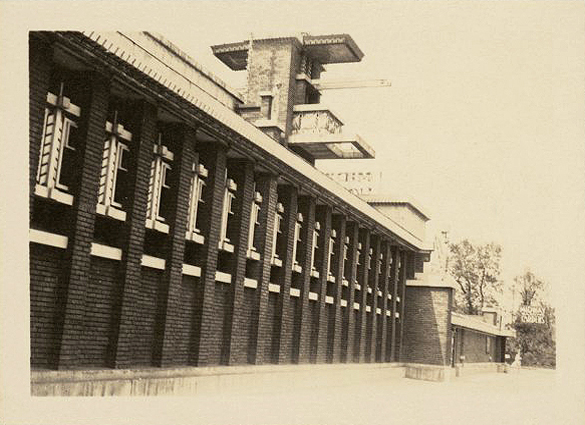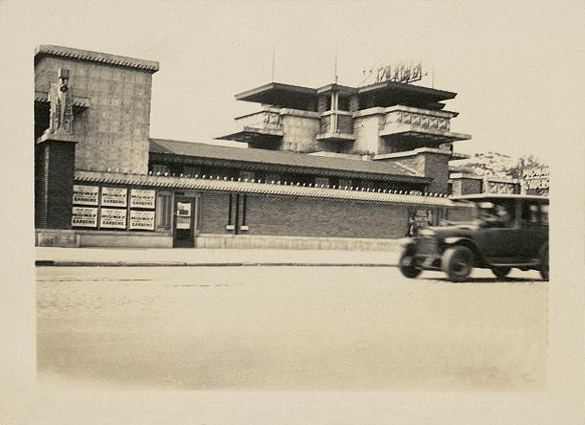|
|
|
MIDWAY GARDENS,
CHICAGO, ILLINOIS (1913 -
S.180) |
|
|
|
HISTORY
FLOOR PLAN PHOTOGRAPHS BY
HENRY FUERMANN (1914)
PHOTOGRAPH BY TAYLOR (1914)
POSTCARDS (1914)
SIDE BY SIDE
TABLESETTING (1914)
NICHOLLS COLLECTION (1924-1926)
ART GLASS
TIMELINE
BACK TO MIDWAY GARDENS
ADDITIONAL WRIGHT STUDIES |
|
|
|
|
During the summer of 1899,
Sans Souci opened as one of
Chicago’s first amusement parks and covered a double city
block. Its main entrance was the corner of Cottage Grove and
Sixtieth, later to be the exact location of Midway Gardens.
Unable to remain profitable, the property was lease by
another group of investors, one of which was Edward C.
Waller. Jr. Because of his father’s prior involvement with
Wright (S.030, 031, 047, 065, 066, 166), he was instrumental
in commissioning Wright as the architect of their new
endeavor. Although Wallace was instrumental in selecting
Wright, Midway Gardens was pure Wright, and pure genius. The
design and the details are spectacular and ornate. Eye
Candy.
Much has been published about Midway
Gardens. How do you describe such a complex building in a
few short paragraphs. Paul Kurty’s “Frank Lloyd Wright and
Midway Gardens” 1998, is essential in understanding this
elaborate work of art. 600 feet by 600 feet, Midway Gardens
was an indoor and outdoor facility. It was comprised of a
music pavilion and stage, arcades on either side of the
terraced summer gardens, an indoor lobby, club, tavern, two
belvederes, promenades, cigar concession stands, two sunken
gardens and pools, dance floors, cantilevered balconies,
terraces, gardens and courtyards. He used bricks and
concrete blocks with designs. Wright not only designed the
building but also the wall murals, concrete block designs,
windows, tables, chairs, lamps, graphics and dishes. He also
designed the many different sculptures and capitals. John
Lloyd Wright worked in his father’s office, prepared many of
the working drawings and acted as superintendent of
construction. Wright worked with two sculptors,
Alfonso Iannelli and Richard Bock. Ezio Orlandi was responsible for
casting. A heated dispute arose between Wright and Iannelli as to who was responsible for
designing the many sculptures or as they were later called
“sprites”.
On June 27th, 1914, the Midway Gardens
officially opened with the National Symphony Orchestra. It
had two excellent years as an entertainment center providing
exceptional dining, orchestra
|
|
music, opera,
exotic dancers and in 1915, Anna Pavlova,
thefamous Russian Dancer.
On August 14, 1914, while Wright was
completing Midway Gardens, word reached him about the
disaster in Wisconsin. A cook set fire to Taliesin and
murdered
Manah, her two children and four members of
Wright’s architectural staff. Wright left for Wisconsin.
Although success at first, Midway Gardens
struggled financially. After only two years, on May 31,
1916, Midway Gardens was sold to the Edelweiss Brewery,
turned into a beer garden and renamed "Edelweiss Gardens."
After struggling, the final blow came in 1920 when
Prohibition was declared. Ownership continued to change
hands and on August 31, 1921 the property was sold to owners
of the E. C. Dietrich Midway Automobile Tire and Supply
Company and became the "Midway Dancing Gardens". In
October of 1923, the Winter Garden was revised and enlarged
by removing balconies (Kruty P47, F44). The four
large male and female sprites (Cube, Octagon, Triangle,
Sphere) were moved out into the Summer gardens. Benny
Goodman even played there in 1924. In the spring of 1929,
the building was leased to its final owner, Sinclair Filling
Station & Car Wash. The building was finally demolished in
October of 1929. Midway Gardens was bulldozed into Lake
Michigan as break wall. The building didn't go down without
a fight. Two wrecking companies went out of business trying
to demolish the concrete structure. The company that finally
demolished Midway Gardens lost a considerable amount of
money on the job.
There are many classic Wright details. The
basic material are brick and patterned concrete blocks.
There are cantilevered and trellised roof overhangs and
cantilevered balconies, decoratively designed metal fascia
cornices. Horizontal lines, columns, hidden entries,
horizontal rows of leaded glass windows and rows of leaded
glass doors that open outward, vases, light trees, pedestal
bases and sculptures, many, many sculptures.
Text by Douglas Steiner, Copyright 2008.
|
|
|
|
|
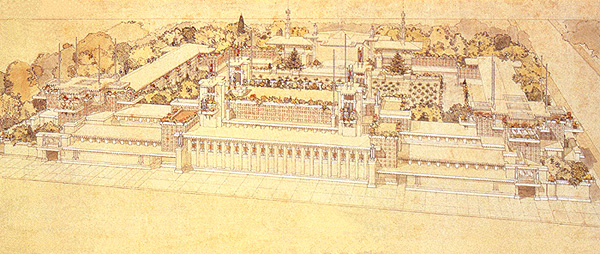 |
|
Original drawing of the Midway Gardens, Copyright The
Frank Lloyd Wright Foundation, Scottsdale, AZ. |
|
|
|
|
|
|
|
|
HISTORY |
|
|
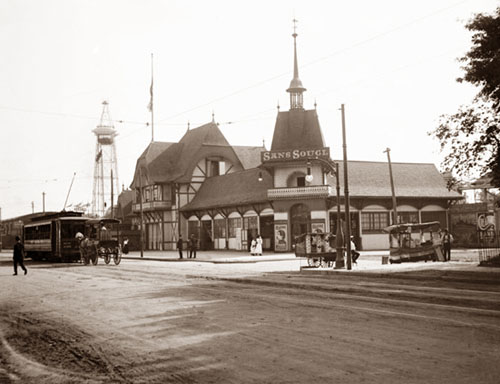 |
|
During the summer of
1899, Sans Souci Amusement Park opened as one of Chicago’s
first amusement parks and covered a double city block. Its
main entrance was the corner of Cottage Grove and Sixtieth,
later to be the exact location of Midway Gardens.
Photographed 1908. |
|
|
 |
|
Postcard: Looking east from Sans Souci Park, Chicago, Ill. |
| |
|
|
|
|
|
|
MIDWAY GARDENS FLOOR PLAN |
|
|
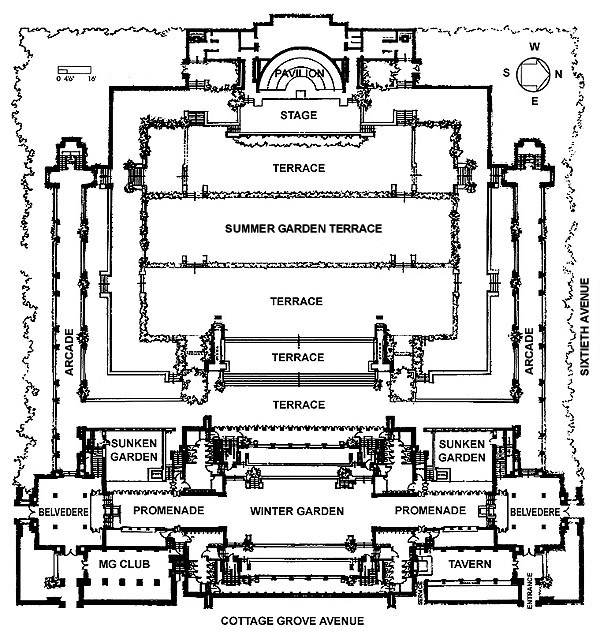 |
|
|
|
|
|
|
|
PHOTOGRAPHS BY HENRY FUERMANN & SONS,
SEPTEMBER 1914 |
|
|
Midway
Gardens, Chicago, Illinois, Fuermann Photographs, 1914 (1913
- S.180). Set of 23 historic photographs by Henry Fuermann &
Sons, documenting Midway Gardens in September 1914. Henry
Fuermann & Sons photographed many of the buildings in the
Chicago area. These Midway Gardens images photographed in
1914 are an invaluable record of Wright's Masterpiece. The
Images are the most complete record of Midway Gardens as
Wright envisioned it.
“Midway Gardens was an indoor and outdoor facility. It was
comprised of a music pavilion and stage, arcades on either
side of the terraced summer gardens, an indoor lobby, club,
tavern, two belvederes, promenades, cigar concession stands,
two
|
|
sunken
gardens and pools, dance floors, cantilevered balconies,
terraces, gardens and courtyards. He used bricks and
concrete blocks with designs. Wright not only designed the
building but also the wall murals, concrete block designs,
windows, tables, chairs, lamps, graphics and dishes. He also
designed the many different sculptures and capitals. John
Lloyd Wright worked in his father’s office, prepared many of
the working drawings and acted as superintendent of
construction...” Frank Lloyd Wright and Midway Gardens.
Kurty, 1998.
Set of
23 historic photographs by Henry Fuermann & Sons. Courtesy
of The Art Institute of Chicago. (S#0124.84.1025
: 1-23) |
|
|
|
|
|
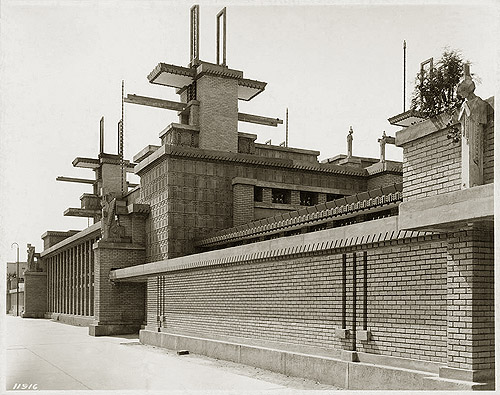 |
|
1) Cottage Grove Avenue
from the Northeast. Winter Garden to the left, Tavern to
the right. Both towers are prominent above the Winter
Garden. Patterned concrete blocks, Two Queen of the Gardens
and three Sprite statues are visible.
(S#0124.84.1025-1) |
|
|
|
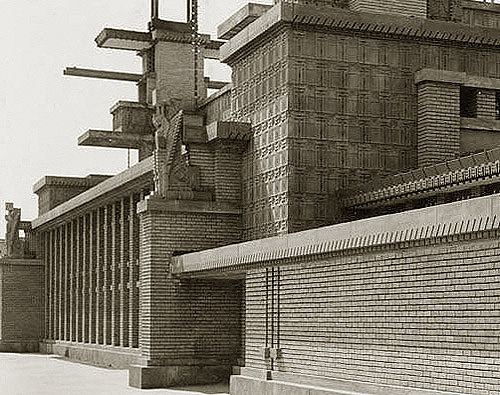 |
|
1A) Detail of the Winter Garden to the
left. Detail of the South tower, patterned concrete blocks
and two Queen of the Gardens statues. |
|
|
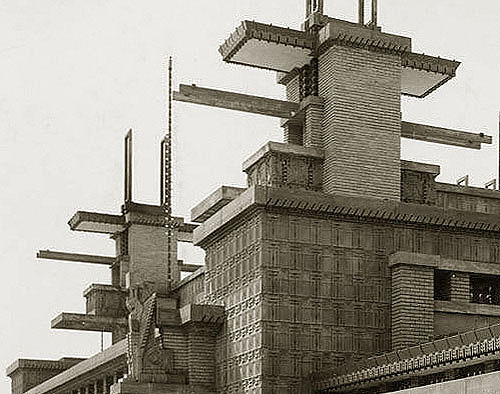 |
|
1B) Detail of the South (left) and
North Towers with cantilevered roof overhangs and
cantilevered balconies and decorative metal fascia cornices.
Two patterned concrete block details, one for walls and the
second for balconies. |
|
|
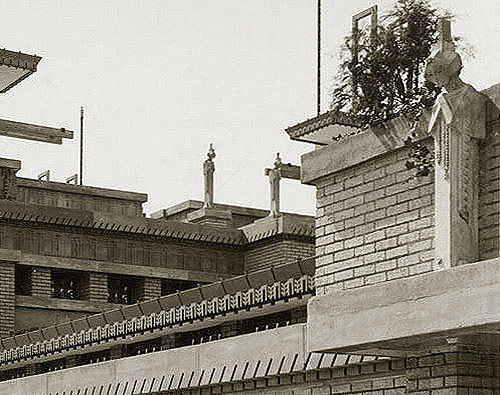 |
|
1C) Detail of three
Sprite statues. The Sprite on the right is above the North
Cottage Grove entrance. |
|
|
|
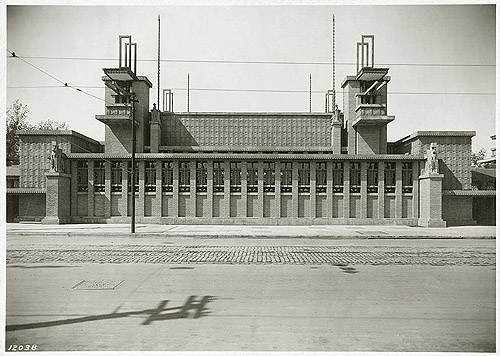 |
|
2) Winter Garden and
Cottage Grove Avenue viewed from the East.
(S#0124.84.1025-2) |
|
|
|
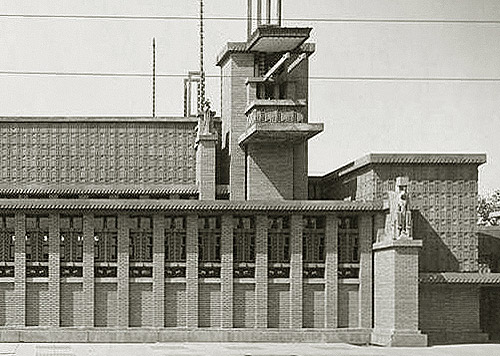 |
|
2A)
Detail of the Northern
end of the Winter Garden. Queen of the Gardens statue on the
right, a Sprite is just to the left of the Tower. |
|
|
|
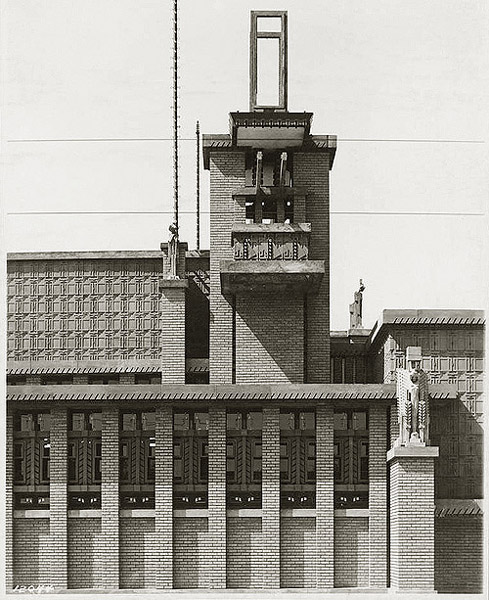 |
|
3) Northern end of the
Winter Garden. Queen of the Gardens statue on the right, a
Sprite is just to the left and right of the Tower. Two
different patterned concrete blocks are visible.
(S#0124.84.1025-3) |
|
|
|
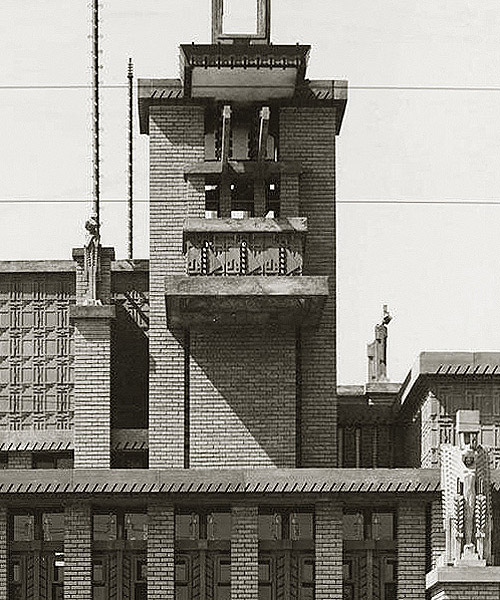 |
|
3A) Detail of the
Northern Tower. Three Tower patterned concrete blocks are
visible, one for walls and the second for balconies. |
|
|
|
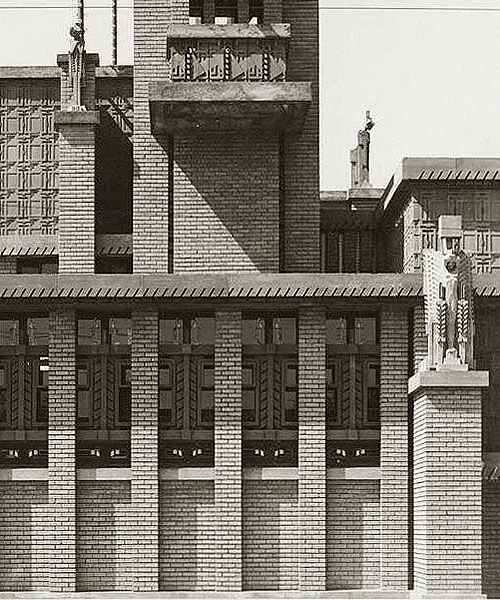 |
|
3B) Detail of the
Northern end of the Winter Garden with vertical brick
columns. Queen of the Gardens on the right, a Sprite is just
to the left and right of the Tower. |
|
|
|
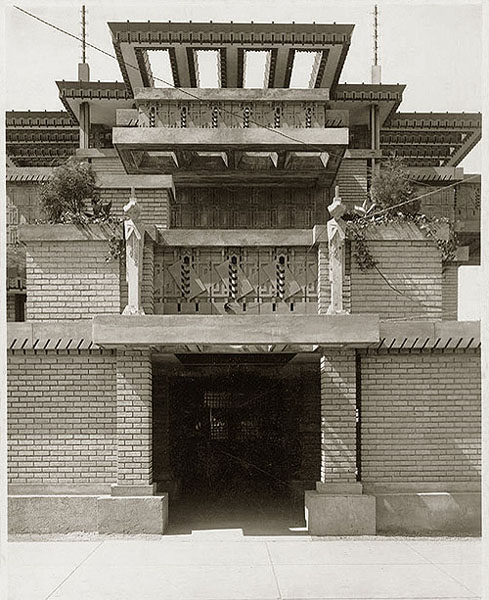 |
|
4) North entrance from
Cottage Grove Avenue.
(S#0124.84.1025-4) |
|
|
|
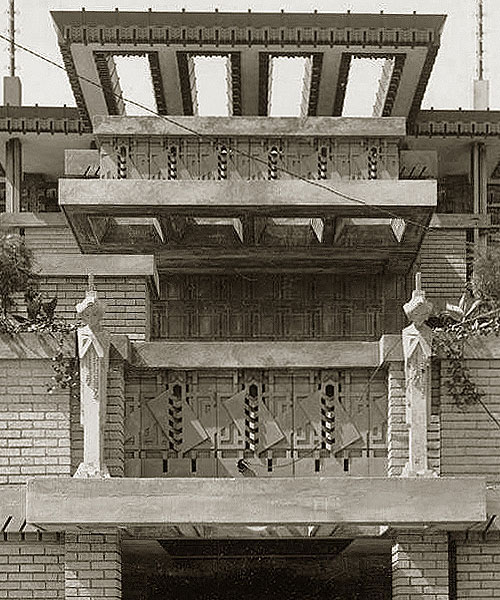 |
|
4A)
Detail of the Entrance
includes three cantilevered and trellised roof overhangs,
patterned balcony concrete blocks, decorative metal fascia
cornices and two Sprites. |
|
|
|
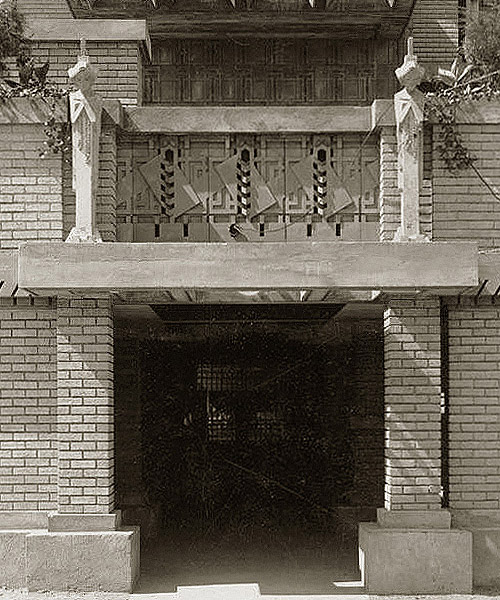 |
|
4B) Detail of the front doors, which
open outward, leading into the Belvedere are hidden
approximately twenty-five feet within the entrance. Details
of patterned balcony concrete blocks and Sprites. |
|
|
|
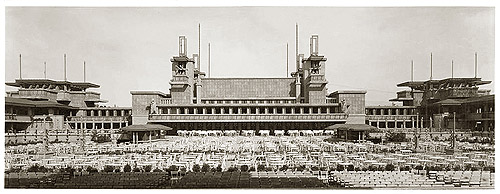 |
|
5) Full view of the
interior of the Eastern side, viewed from the stage looking
out over the Summer Garden. Winter Garden in the center is
flanked on either side by the Promenades and the Belvederes
on either end.
(S#0124.84.1025-5) |
|
|
|
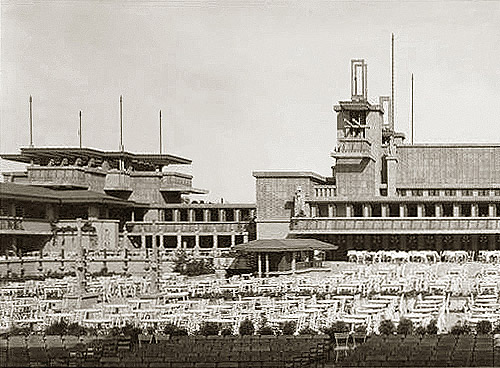 |
|
5A) Detail of the Northeast
corner of the interior, viewed from the stage looking out
over the Summer Garden. The Promenade sits between the
Northern Belvedere on the left and the Winter Garden on the
right. Cantilevered roof overhangs and cantilevered
balconies are visible on the upper levels of the Belvedere. |
|
|
|
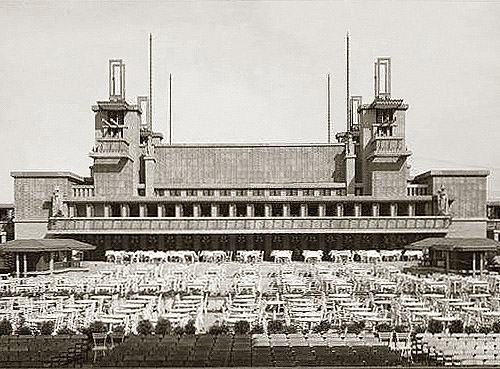 |
|
5B) Detail of the Symmetry of the
Winter Garden. Not only are there two towers, two Queen of
the Garden statues and two Sprites on this Western side, but
the same exists on the Eastern side. |
|
|
|
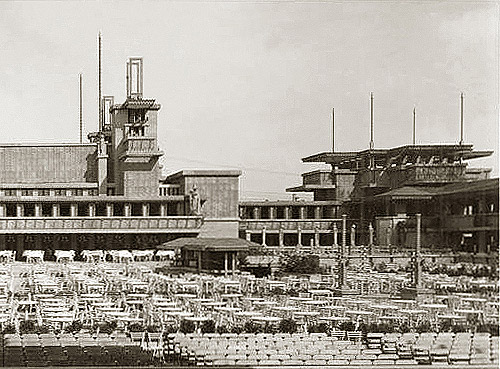 |
|
5C) Detail of the Southeast
corner of the interior, viewed from the stage looking out
over the Summer Garden. The Promenade sits between the South
Belvedere on the right and the Winter Garden on the left.
Cantilevered roof overhangs and cantilevered balconies are
visible on the upper levels of the Belvedere. |
|
|
|
|
|
|
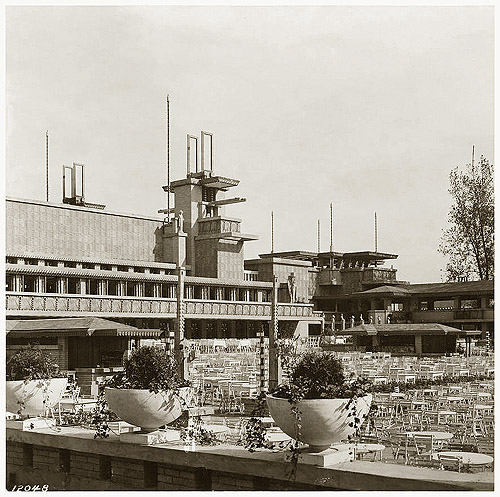 |
|
6) The Southeast
corner of the interior, viewed from the North Terrace
looking out over the Summer Garden. The Winter Garden on the
left, the South Belvedere is in the center, and the South
Arcade is on the right. Vases, Totem poles and Light Tree
are visible in the foreground.
(S#0124.84.1025-6) |
|
|
|
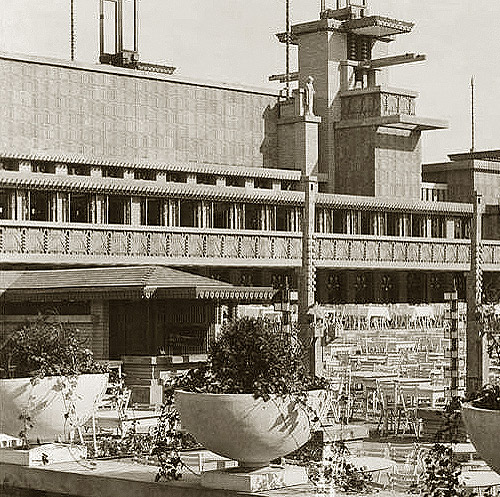 |
|
6A) Detail of the two forms of
patterned concrete blocks face the exterior of the Winter
Garden, one for walls and the second for balconies. Rows for
doors open outward in the balcony. Totem poles and Light
Tree are visible in the foreground. North Refreshment Stand
is on the left. |
|
|
|
 |
|
6B) Detail of
the South Belvedere. The Sunken Garden is just beyond the
row of eight Sprites. The South Arcade is on the right. The
South Refreshment Stand is visible just in front of it. |
|
|
|
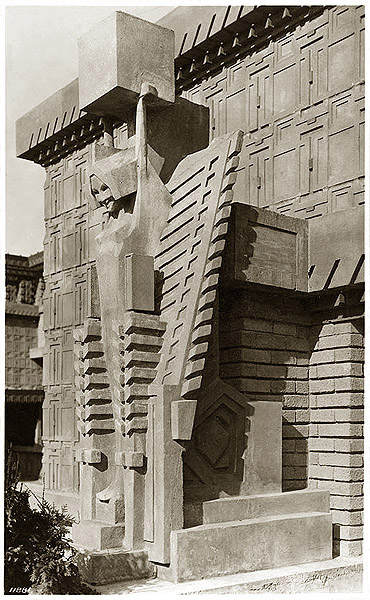 |
|
7) The Queen of the
Gardens. Located on the North end of the Winter Garden,
facing the Summer Garden.
(S#0124.84.1025-7) |
|
|
|
|
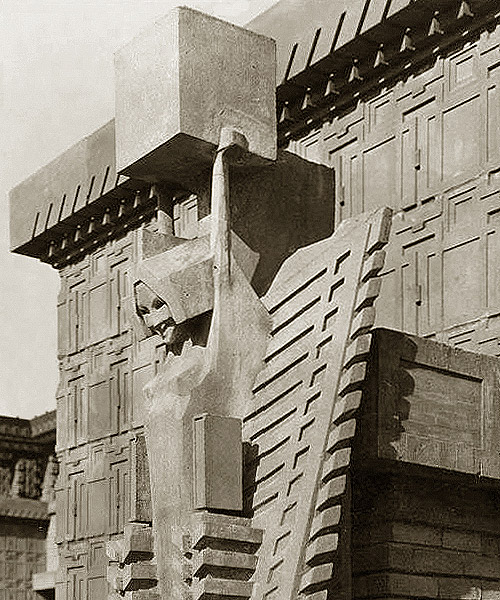 |
|
7A) Detail of the
Queen of the Gardens. Patterned concrete wall blocks visible
behind the sculpture. |
|
|
|
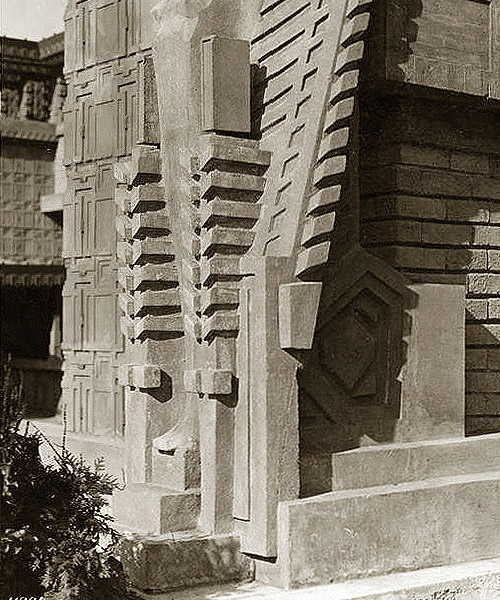 |
|
7B) Detail of the
Queen of the Gardens base. Patterned concrete wall blocks
visible behind the sculpture. |
|
|
|
 |
|
8) Totem poles and
Light Tree. The South Belvedere is seen in the background.
(S#0124.84.1025-8) |
|
|
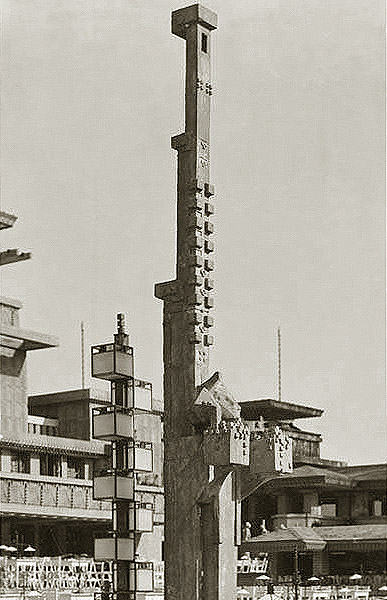 |
|
8A) Detail of the
Totem poles and Light Tree. |
|
|
|
|
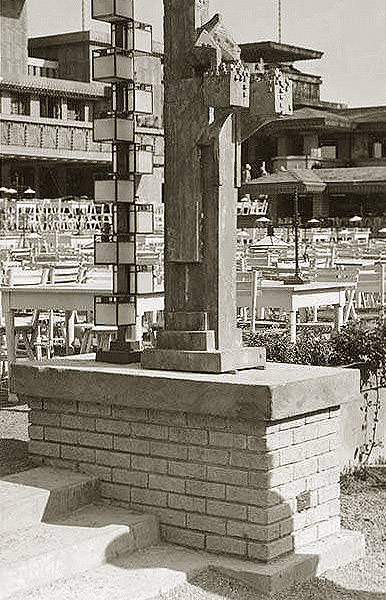 |
|
8B) Detail of the
Totem poles and Light Tree base. |
|
|
|
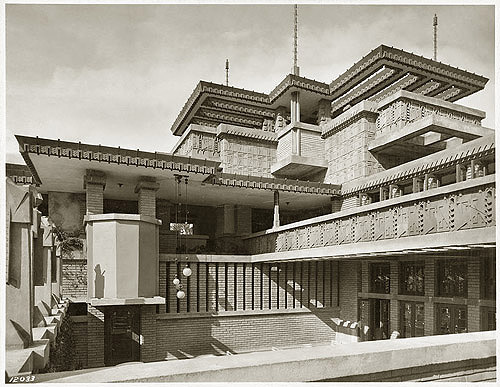 |
|
9) Looking Northeast over the Sunken Garden to the North Belvedere.
Cantilevered roof overhang and small cantilevered balcony.
Patterned concrete wall and balcony blocks. Decoratively
designed metal fascia cornices. A row of Sprites are visible
on the left.
(S#0124.84.1025-9) |
|
|
|
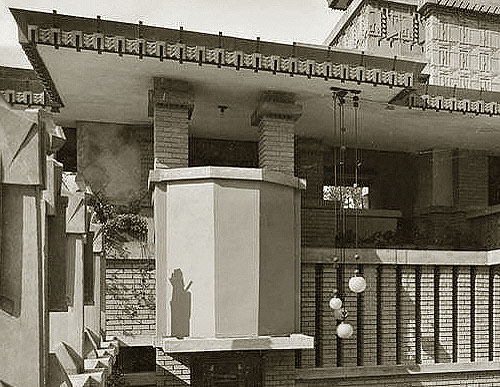 |
|
9A) Detail of the
Southwest corner of the North Belvedere. Cantilevered roof
overhang with metal fascia cornice. One of the Wright
designed hanging lights is visible just to the right of the
small cantilevered balcony. A row of Sprites are visible on
the left. |
|
|
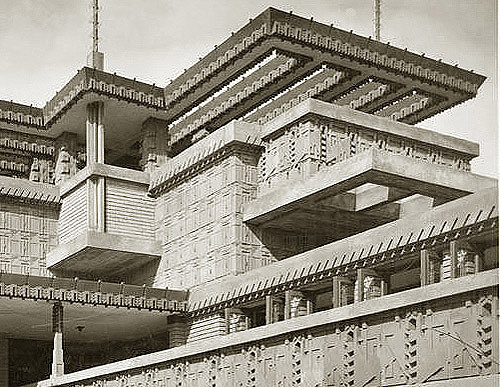 |
|
9B) Detail of the
South side of the North Belvedere. Cantilevered roof
overhang with metal fascia cornice and cantilevered balcony.
Patterned concrete wall and balcony blocks. A row of balcony
doors open outward. |
|
|
|
|
|
|
|
|
|
|
|
|
|
|
|
|
|
|
|
|
|
|
|
 |
|
23A) Detail of Mural
and built-in cigar stand. |
|
| |
|
|
|
|
|
|
MIDWAY GARDENS BY J. W. TAYLOR (1914) |
|
|
|
|
|
|
|
|
|
|
|
MIDWAY GARDEN POSTCARDS (1914) |
|
|
|
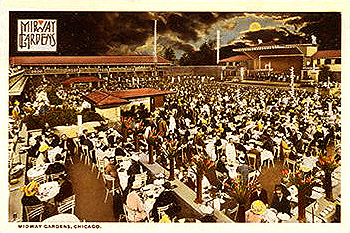 |
|
1)
Midway
Gardens postcard, looking Southwest across the Summer
Garden. South Arcade on the left, Music Pavilion is on the
right. Published in by Curt Teich, Chicago. See side by side comparison. |
|
|
|
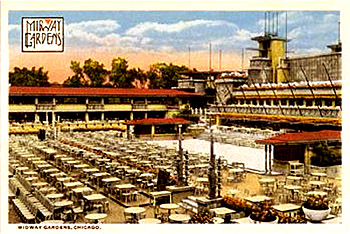 |
|
2) Midway Gardens
postcard, looking Northeast across the Summer Garden.
The North Arcade is on the left, the North Belvedere is on
the right. Published by Curt Teich, Chicago. |
|
|
|
|
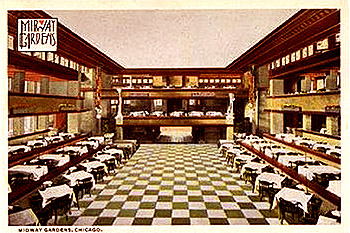 |
|
3) Midway Gardens
postcard, Winter Garden looking North. Published by
Curt Teich, Chicago. |
| |
|
|
|
|
|
|
SIDE BY SIDE |
|
|
|
Left: This was the
original photograph used for the postcard to the right. Summer Garden at night, looking Southwest toward the Stage.
South Arcade is to the left. Photograph by J.W. Taylor,
Chicago, 1914. |
|
Right: Midway
Gardens postcard, looking
Southwest across the Summer Garden. South Arcade on the
left, Music Pavilion is on the right. Published by
Curt Teich, Chicago. |
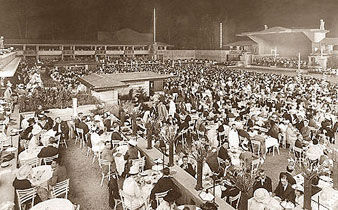 |
|
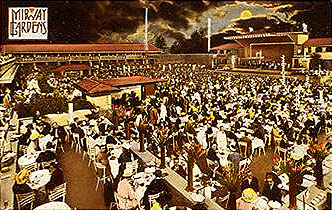 |
|
|
|
|
|
|
|
|
|
|
|
|
|
MIDWAY GARDENS TABLESETTING (1914) |
|
|
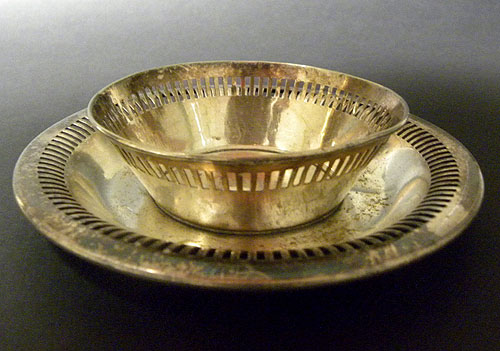 |
|
|
Wright designed many decorative
details for the Midway Gardens. Was this silver dish (above) produced
for Wright's Midway Gardens or some other? That was the question we
attempted to unravel. We did an extensive search through
everything that was published about the Midway Gardens. We
also contacted the Meriden Historical Society.
It is conclusive that Wright designed many
of the details and furnishings for the Midway Gardens.
Sculptures, vases, leaded glass windows, interior tables and chairs
(two designs,
M3 pl 493, 494),
garden furniture (two
variations,
M3 pl 497, 498),
linen,
lighting, china and a silver vase. He also designed the monogram that appeared on many items. Like the monograph
applied to items at the
Imperial Hotel, the monograph appeared
on many items not designed by Wright like the Beer Stein (Fig.
5) and Tea Pot (Fig 9). It is also clear that
items were ordered that did not have Wright's touch. Wright
designed two versions of a garden table and chairs for the exterior
Summer Garden. This design was never executed. They chose a white wood set
instead. A design for a beer stein (Fig. 5) was included in
one of Wright's drawings, and was more of a geometric design
than the one that was used and engraved with the Midway
Garden Monogram. The Coffee Pot Wright designed for Midway
Gardens was a variation of the design for the Imperial
Hotel (Fig 7c), very geometric in shape. Wright's design was not
selected. The Midway Gardens Coffee / Tea Pot was most
likely ordered from a catalog and imprinted with the MG
Monogram (Fig 2c).
Hence we come to this silver dish (above). First a number
of questions arise. Who manufactured it and when was
produced? Were there other Midway Gardens? We start with the
markings on the bottom.
Top: "00274, Midway Gardens" (Fig
10c). This
piece is numbered, but the Meriden Historical Society did
not have a record that matched. Of interest is the minute
mark between and below the "...y G..." in Midway Gardens. It
is approximately 1/64" in size. It is a stamped "W" inside a
"C". It resembles the original mark used by The Watrous Mfg.
Co., which merged with Meriden Britannia in 1898.
Bottom: "M B C E P" (Fig
10d). Each has raised letter
within a stamped box. This have been identified as Meriden Britannia Company Electro Plate.
Meriden, Connecticut, was the American capital for pewter
and silver manufacture in the 19th century. The Meriden
Britannia Company was formed in 1852, in Meriden, Conn. They
initially manufactured products using a metal alloy called
Britannia, approximating the appearance of pewter. In the
late 19th century, when silver began replacing pewter in
American homes, they also produced silver plated products. In 1898, they
were one of the major companies that formed International
Silver. MB continued to
use their marks into the 1930's. Some of the other companies
included:
Barbour Silver Company, Hartford, Conn.
C. Rogers & Brothers, Meriden, Conn
Derby Silver Company, Derby and Meriden, Conn.
Holmes & Edwards Silver Company, Bridgeport, Conn.
Manhattan Silver Plate, Lyons, New York
Meriden Britannia Company, Meriden |
|
Middletown Plate Company, Middletown and Meriden, Conn.
Norwich Cutlery, Norwich, Conn.
Rogers Cutlery, Hartford, Conn.
Rogers and Brothers, Waterbury, Conn.
Rogers and Hamilton, Waterbury, Conn.
Rogers, Smith & Co., Hartford, Conn.
Simpson, Hall, Miller & Company, Wallingford, Conn.
Simpson Nickel Company, Wallingford
Standard Silver Company, Ltd., Toronto, Canada
Watrous Manufacturing Company, Wallingford, Conn.
Wilcox Silver Plate, Meriden, Conn.
William Rogers Manufacturing Company, Hartford, Conn.
Each firm continued to stamp their maker's mark on
designs, but marketing and production was at the same
expanded facility.
Left: "Crown" with two triangles, "Wheat?",
"Star" (Fig 12e). All three are stamped, and unidentified.
Right: "Shield with small Star in a
Crescent" (Fig 12f). Note: Manhattan Silver
Plate, one of the companies that joined MB, had a Star
within a Crescent mark (TM p148). The second is a "Scale
within a Shield". Examples of this can be seen on MB items
as late as 1951. The third is a "Thistle within a Circle". All three are stamped.
After an exhaustive study of the markings
on the bottom of the piece, the conclusion seems to be that
the piece was produced after the merger in 1898, and before
1930, so it fits the time frame of Wright's MG.
Were there other Midway Gardens during that
time period? There may have been one or two, but it would
have had to have been a sizeable facility in order to place
an order like this and customized it with your name
imprinted and numbered. There were no other sizeable
"Midway Gardens" during that time period.
If this was used at Wright's MG, why would
this piece not have the MG monogram? It may have been
the size of the piece itself and its use. 1" in height, 5.5"
wide, with the smaller bowl being 3.75" wide. The MG
Cup and Saucer was designed without the monogram, and was
produced without it. There were a very
limited number of Imperial Hotel silver coffee
services that survived. Some were imprinted with the IH
monogram and some without. The only place for the monogram on this piece was the inside bottom of the dish, and if it
was used as a condiment, small serving bowl or candy dish,
the monogram would have been covered, hence no need to stamp
it in a visible area.
Of interest is the design itself. It is
consistent with Wright's geometric designs for Midway
Gardens. The perforated
setting surrounding the edges of the "bowl" and "tray"
mirrors the front of Midway Gardens (Fig 9d), the details of Wright's
"Queen of the Garden" sculpture (Fig
9e) and is stereotypical of
Wright's Prairie style.
Our summary is not conclusive, but we would
lean toward the conclusion that this silver dish was not
designed by Wright, but was used in Wright's Midway Gardens, and most
likely ordered from a catalog, and ordered in a quantity
that would allow Midway Gardens to imprint the bottom.
Text by Douglas M. Steiner, Copyright
2010. |
| |
|
|
|
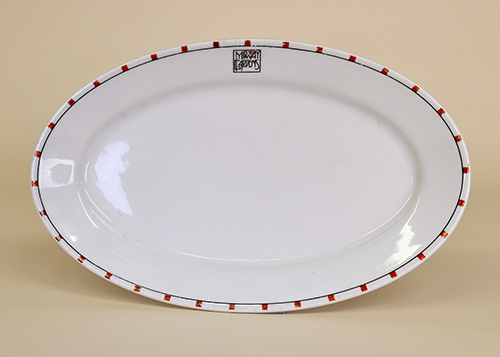 |
| 1)
Midway Gardens Oval Platter. Designed by Frank Lloyd
Wright. Manufactured by Bauscher, Weiden, Germany.
1914.
(S#0124.78.1024) |
| |
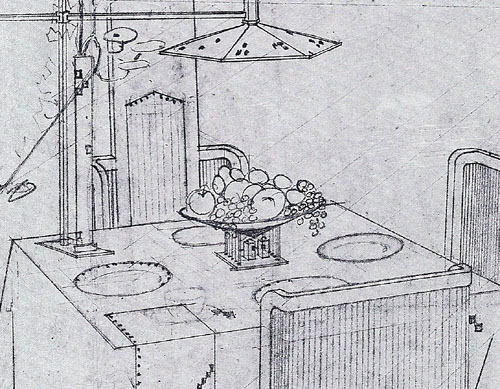 |
| 1B)
Table setting designed by Frank Lloyd Wright.
Includes example of plate design. Courtesy of the
Frank Lloyd Wright Foundation. |
| |
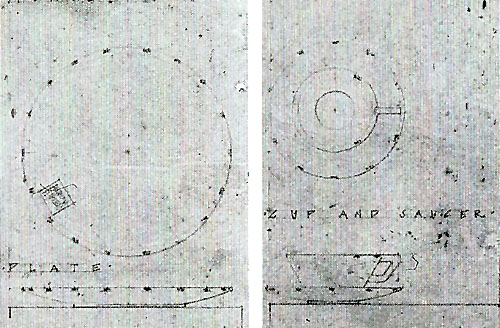 |
| 1B)
Detail of the Plate and the Cup and Saucer designed by Frank
Lloyd Wright. Plate design included MG monogram. Cup
and Saucer design lacked monogram, and was produced
without it. Courtesy of the Frank Lloyd Wright
Foundation. |
| |
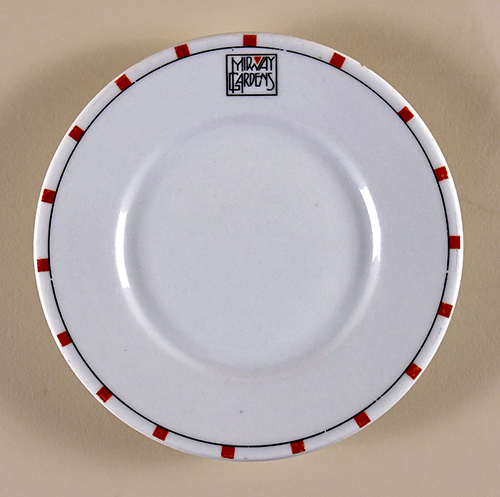 |
| 2)
Midway Gardens Plate. Designed by Frank Lloyd
Wright. Manufactured by Bauscher, Weiden, Germany.
1914.
(S#0124.69.0724) |
| |
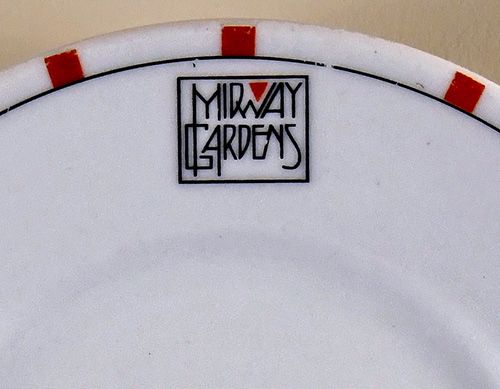 |
| 2B)
Detail of Midway Gardens Plate. Designed by Frank
Lloyd Wright. Manufactured by Bauscher, Weiden,
Germany. 1914.
(S#0124.69.0724) |
|
2c |
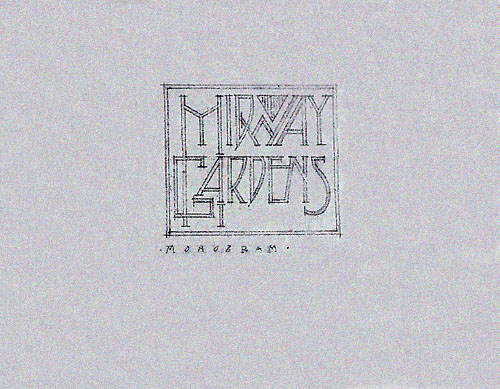 |
| 2C)
Midway Gardens Monogram designed by Frank
Lloyd Wright. Courtesy of the Frank Lloyd Wright
Foundation. |
| |
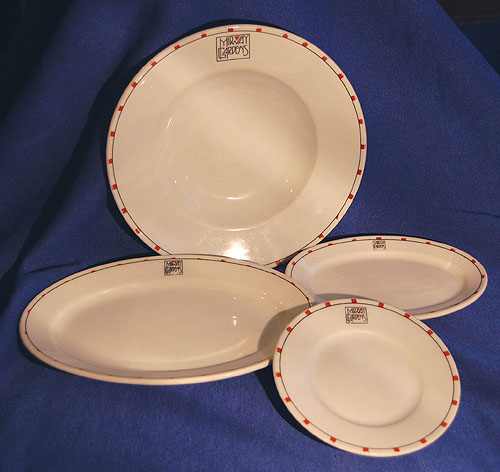 |
2D)
Midway Gardens Plates. Designed by Frank Lloyd
Wright.
All four are marked on the back with "New
York-Chicago Bauscher Weiden (Germany) 1914".
Top:
Large round soup or salad 9" across. Impressed mark
in oval "Bauscher Weiden", and impressed away from
the other marks is "23".
Center Left: Large platter. 9 3/4" by 6".
Impressed mark in oval "Bauscher Weiden", and
impressed away from the other marks is "00".
Center Right: Small platter. 7" by 4 1/4".
Impressed mark in oval "Bauscher Weiden", and
impressed away from the other marks is "00".
Foreground: Small round plate 6" across.
Impressed mark in oval "Bauscher Weiden", and
impressed away from the other marks is "15".
(The Impressed Numbers may have to do with the
shapes of the pieces. Two platters are marked with
"00". The small plate "15" and the large Bowl "23".)
All are manufactured by Bauscher, Weiden, Germany.
1914. Photograph courtesy of private collector. |
| |
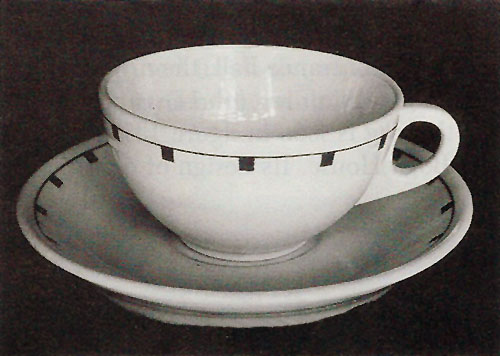 |
| 3)
Midway Gardens Cup and Saucer, 1914. Designed by Frank
Lloyd Wright. The Midway Gardens Cup and Saucer was designed
without the monogram, and was produced without it.
Note: Pattern is inversed on this Sup & Saucer.
Squares are below the line, not above like on all
the other patterns. This was John Lloyd Wright's Cup
& Saucer. It was manufactured by Shenango China, New
Castle not Bauscher, Weiden, Germany which
manufactured all the other Midway Gardens ceramics.
This could account for the difference. Courtesy of David Hanks,
Decorative
Designs, 1979, p 125. |
| |
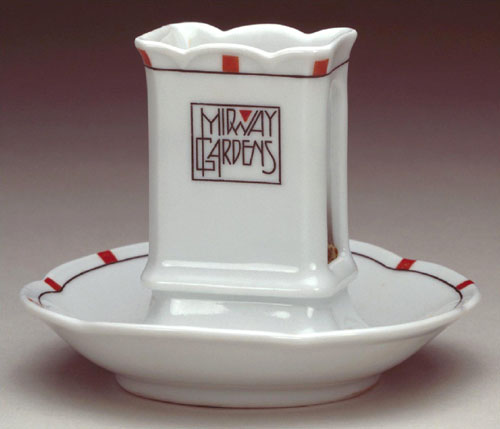 |
| 4)
Midway Gardens Ash Tray and Match Holder. Not
verified as a Wright designed. Most likely the red
squares and monogram adapted to ash tray. Manufactured by Bauscher, Weiden,
Germany. 1914. Courtesy of The Minneapolis Institute of
Arts. |
|
5 |
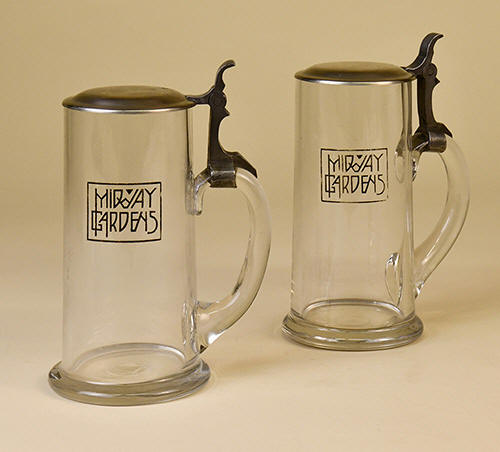 |
|
5)
Midway Gardens Beer Stein. Not verified as a Wright
designed. A design for a beer stein was
included in one of Wright's drawings, and was more
of a geometric design than this one that was used
and engraved with the Midway Garden Monogram. Glass
and pewter.
7" x 4" x 5". 1914.
(S#0124.83.0925
: 1-2) |
| |
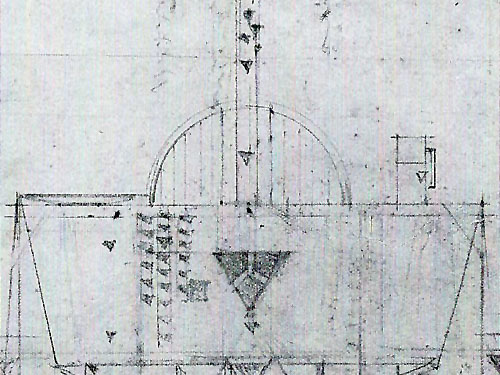 |
| 5B)
Detail of table setting with rendering of Wright's
concept for a Midway Gardens Beer Stein (right side
of table). Design was
never realized. Courtesy of the Frank Lloyd Wright
Foundation. |
| |
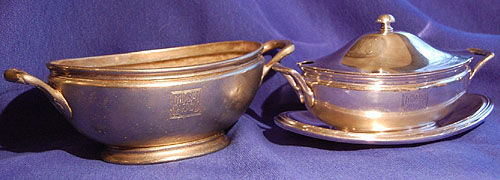 |
| 6)
Midway Gardens Soup Terrines with Midway
Gardens monogram. Left: Two Pint Soup Terrine.
9 5/8" long Handle to Handle by 4 3/4" wide by 3 1/4
Tall at the center. Right: One Pint
Soup Terrine.
8" long handle to handle by 4 1/4" Wide by 2 1/2"
Tall at the center. When combined, the One Pint
Soup
Tray, Terrine and Lid is 4 1/2" Tall to the top of
the lid. The owner purchased
the
One Pint Soup
Terrine at a
antique store in his neighborhood, which is no
longer in business. Photograph courtesy of private
collector. |
| |
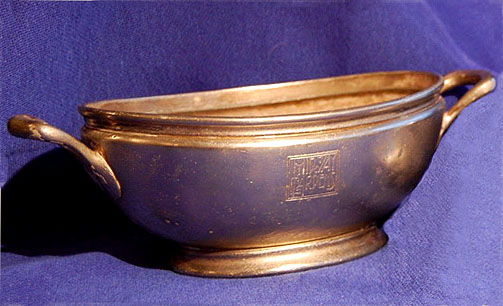 |
| 6B)
Midway Gardens Soup Terrine with Midway
Gardens monogram. Two Pint Soup Terrine.
9 5/8" long Handle to Handle by 4 3/4" wide by 3 1/4
Tall at the center.
Photograph courtesy of
private collector. |
| |
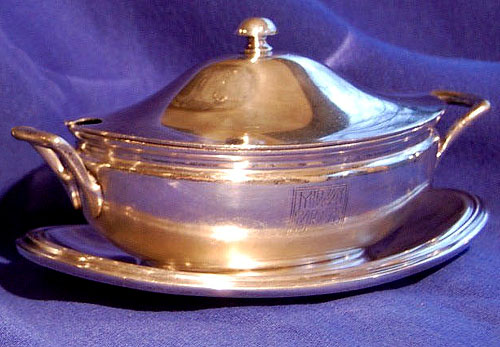 |
| 6C)
Midway Gardens Soup Terrine and Base with Midway
Gardens monogram.
One Pint Soup
Terrine.
8" long handle to handle by 4 1/4" Wide by 2 1/2"
Tall at the center. When combined, the One Pint
Soup
Tray, Terrine and Lid is 4 1/2" Tall to the top of
the lid. The owner purchased
the
One Pint Soup
Terrine at a
antique store in his neighborhood, which is no
longer in business. Photograph courtesy of private
collector. |
| |
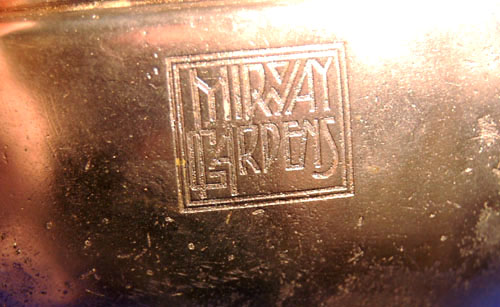 |
| 6D)
Detail of the Midway Gardens Soup Terrine's monogram. |
| |
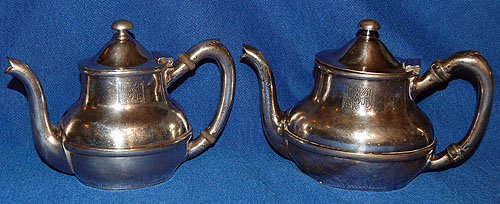 |
|
7) Midway Gardens Tea
Pots with Midway
Gardens monogram. Left: One Pint Tea Pot.
5 1/2" Tall by 7 1/2" Wide Handle to Spout. Right:
Two Pint Tea
Pot.
5 3/4" Tall by 8 1/2" Wide Handle to Spout.
Photograph courtesy of
private collector. |
| |
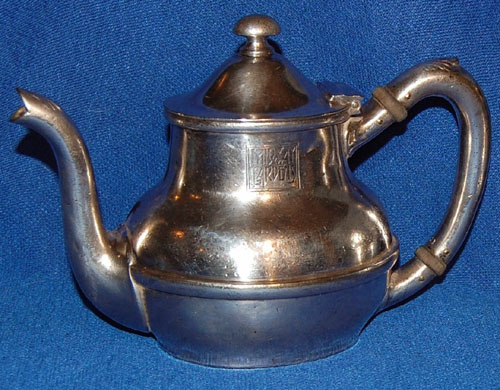 |
|
7B) Midway Gardens Tea
Pot with Midway
Gardens monogram. One Pint Tea Pot.
5 1/2" Tall by 7 1/2" Wide Handle to Spout.
Photograph courtesy of
private collector. |
| |
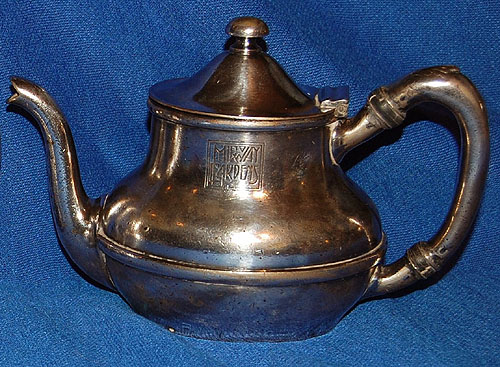 |
|
7C) Midway Gardens Tea
Pot with Midway
Gardens monogram. Two Pint Tea Pot.
5 3/4" Tall by 8 1/2" Wide Handle to Spout.
Photograph courtesy of
private collector. |
| |
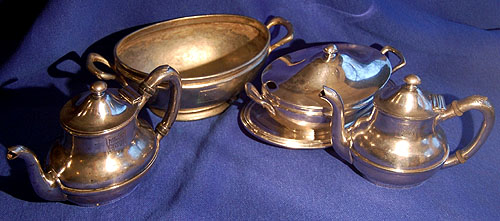 |
|
8)
Midway Gardens Soup Terrines (2) and Tea Pots (2) with Midway
Gardens monogram. Left to Right: Two Pint Tea Pot,
Two Pint Soup Terrine, One Pint Soup Terrine with
Tray and Lid, One Pint Tea Pot. Photograph courtesy of
private collector. |
|
7 |
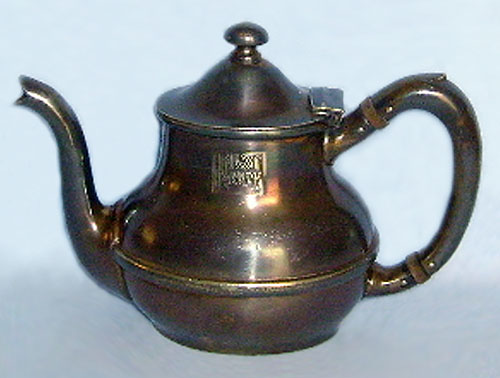 |
9)
Midway Gardens Tea Pot. The Coffee Pot Wright
designed for Midway Gardens was a variation of the
design for the Imperial
Hotel, very geometric in shape. Wright's design was not
selected. This Midway Gardens Coffee / Tea Pot was most
likely ordered from a catalog and imprinted with the MG
Monogram. 1914.
History of this Tea Pot: My Great Aunt and
Uncle lived in Joliet, and used to visit Midway
Gardens back in the 1920's, they loved the
restaurant and the bands that played there. They
were at the restaurant on one of their visits and my
Great Aunt did not feel well that evening, as she
thought she might be expecting a Baby. The tea that
evening was the only thing that calmed her, so she
had their chauffeur purchase a tea pot full of hot
water and the cup of tea for the drive home. Over
the years she told our family about the unpleasant
drive home from that evening, and the other
exciting evenings at Midway Gardens. Courtesy
of Jeanne, Happy Trails, Ruby Lane. |
| |
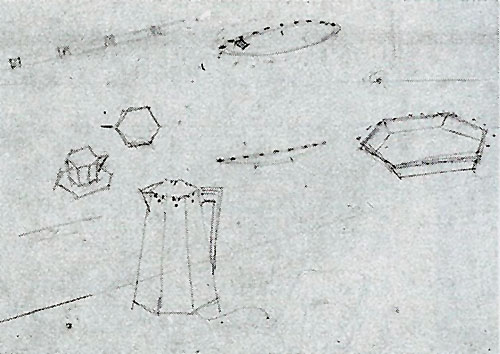 |
| 9B)
Detail of Wright's
concept for a Midway Gardens Coffee Server. The
designed was a variation of the design for the Imperial
Hotel, very geometric in shape. Design was
never realized. Courtesy of the Frank Lloyd Wright
Foundation. |
|
7c |
 |
| 9C) Detail of Wright's concept for a
Imperial Hotel Coffee
Server. Courtesy of the Frank Lloyd Wright
Foundation. |
| |
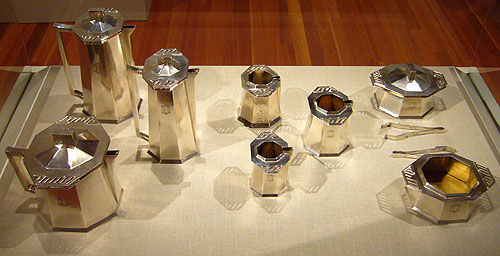 |
| 9D)
Imperial Hotel Coffee
Server on display at the de
Young Museum, San Francisco in 2006. On loan from a
private party. Courtesy of Eric.
(Treasured Hunting) |
|
|
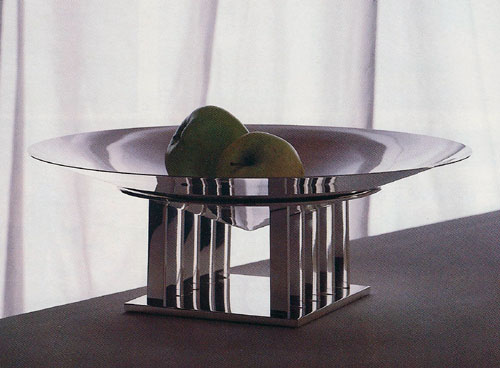 |
| 10)
Midway Gardens Fruit Bowl designed by Frank Lloyd
Wright. This design was never realized. In 1988,
through an agreement with the Frank Lloyd Wright
Foundation, Tiffany & Company executed this
design. Made of sterling silver,
14 inches wide, 5.5 inches high. $11,250.
Courtesy of the Frank Lloyd Wright Foundation and
Tiffany & Company. For additional
information see
"Frank Lloyd
Wright, Decorative Designs Collection", 1988,
1990. |
| |
 |
| 10B)
Table setting designed by Frank Lloyd Wright.
Includes example of Fruit Bowl. Courtesy of the
Frank Lloyd Wright Foundation. |
| |
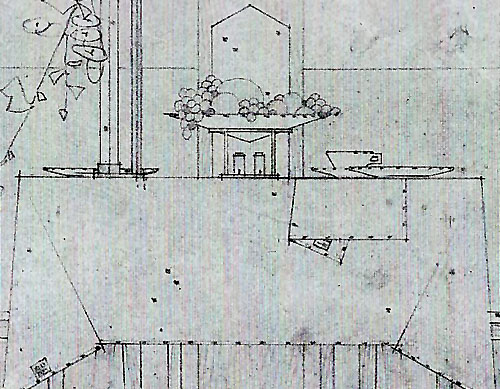 |
| 10C)
Table setting designed by Frank Lloyd Wright.
Includes example of Fruit Bowl. Wright also designed
the linen table cloth and napkin. The design
included the MG monogram and the "Red Squares"
border. Courtesy of the
Frank Lloyd Wright Foundation. |
| |
 |
| 11) The design
of this piece is consistent with Wright's geometric designs for Midway
Gardens. It is 1" in height, 5.5" wide, and the
smaller bowl is 3.75" wide. (S#0124.11.0110) |
| |
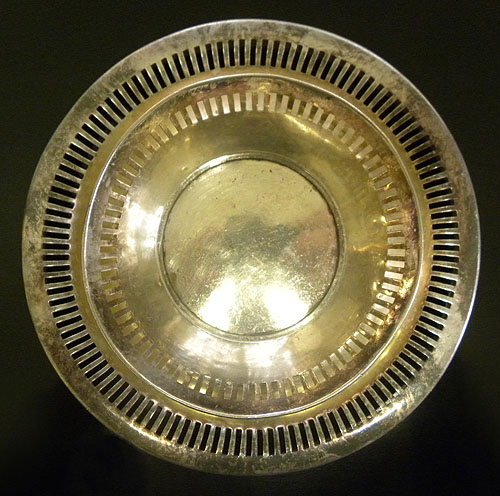 |
| 11B) The perforated
setting surrounding the edges of the "bowl" and "tray"
imitates the Wright designed place setting, and mirrors the front of Midway Gardens, the details of Wright's
"Queen of the Garden" sculpture and is stereotypical of
Wright's Prairie style. |
| |
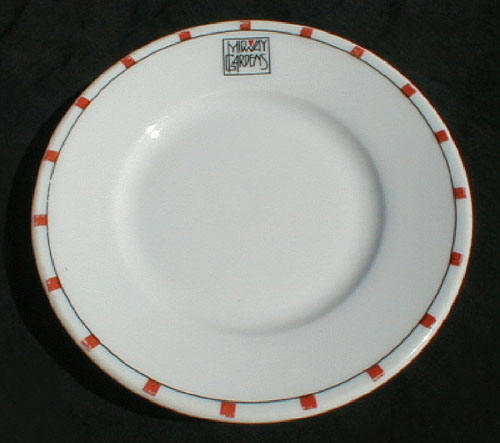 |
| 11C) The perforated
setting surrounding the edges of the "bowl" and "tray"
imitates the Wright designed Midway Gardens place setting. |
|
9d |
 |
|
11D)
The perforated
setting surrounding the edges of the "bowl" and "tray"
mirrors the front of Midway Gardens Winter Garden and is stereotypical of
Wright's Prairie style. |
|
9e |
 |
|
11E)
The perforated
setting surrounding the edges of the "bowl" and "tray"
mirrors the details of Wright's
"Queen of the Garden" sculpture and is stereotypical of
Wright's Prairie style. |
|
|
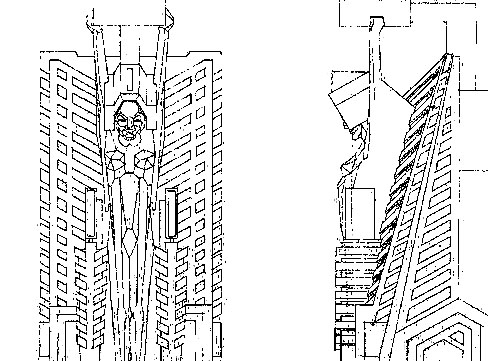 |
|
11F)
This drawing of Wright's "Queen
of the Garden" sculpture accentuates the similarities with
the perforated
setting surrounding the edges of the "bowl" and "tray". |
|
|
 |
|
12)
This view is looking straight
down at the dish. It is flipped over in the next
photograph. |
|
| |
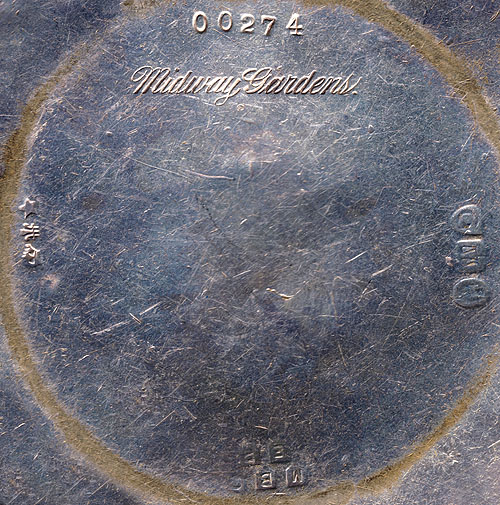 |
| 12B)
This view is of the bottom of
the dish. |
|
10c |
 |
|
12C) Top: "00274. Midway
Gardens." This piece is numbered, but the Meriden Historical
Society did not have a record that matched. Of interest is
the minute mark between and below the "...y G..." in Midway
Gardens. It is approximately 1/64" in size. It is a stamped
"W" inside a "C". It resembles the original mark used by The Watrous Mfg.
Co., which merged with Meriden Britannia in 1898. |
|
10d |
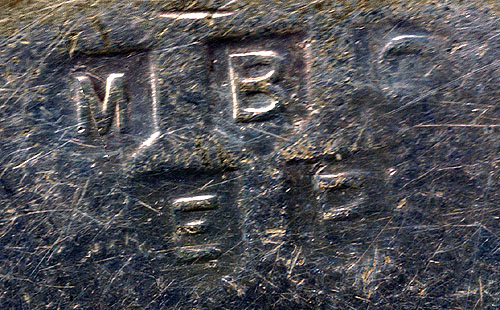 |
| 12D) Bottom: "M B C E P" each has
raised letter within a stamped box. This have been
identified as Meriden Britannia Company Electro Plate.
Meriden, Connecticut, was the American capital for pewter
and silver manufacture in the 19th century. The Meriden
Britannia Company was formed in 1852, in Meriden, Conn. They
initially manufactured products using a metal alloy called
Britannia, approximating the appearance of pewter. In the
late 19th century, when silver began replacing pewter in
American homes, they also produced silver plated products.
In 1898, they were one of the major companies that formed
International Silver. MB continued to use their marks into
the 1930's. |
|
10e |
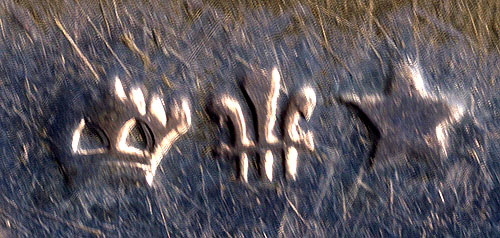 |
| 12E) Left: "Crown" with two
triangles, "Wheat?", "Star". All three are stamped, and
unidentified. |
|
10f |
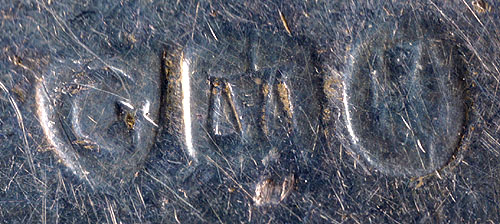 |
| 12F) Right: "Shield with small Star in a
Crescent". Note: Manhattan Silver
Plate, one of the companies that joined MB, had a Star
within a Crescent mark (TM
p148). The second is a "Scale
within a Shield". Examples of this can be seen on MB items
as late as 1951. The third is a "Thistle within a Circle". All three are stamped. |
| |
|
Our summary is not
conclusive, but we would lean toward the conclusion that
this silver bowl was not designed by Wright, but was used in
Wright's Midway Gardens, and most likely ordered from a
catalog, and ordered in a quantity that would allow Midway
Gardens to imprint the bottom. |
|
| |
|
|
|
|
|
|
ERIC MILTON NICHOLLS COLLECTION (1924-1926) |
|
|
|
Midway
Gardens, Chicago, Illinois, Circa 1924-26 (1913 -
S.180). Set of 11 photographs from the Eric Milton
Nicholls Collection, possibly photographed by Burley and
Griffin, circa 1924-1926. This is a very important set
of photographs that document the changes to Midway
Gardens. Designed by Frank Lloyd Wright in 1913. In
October of 1923, the Winter Garden was revised and
enlarged by removing balconies (Frank Lloyd Wright and
Midway Gardens. Kurty, 1998, p47, F44). The four large
male and female sprites (Cube, Octagon, Triangle,
Sphere) were moved out into the Summer gardens. The most
important image in this set is the fountain (#11).
Kruty indicted on page 136 that “...no known photographs
show the promenade’s interior and, thus, the site of
either fountain, it is possible to get some idea of
their forms from drawings and fragments.” This may be
the only image of the |
|
fountain
that exist.
“Midway
Gardens was an indoor and outdoor facility. It was comprised
of a music pavilion and stage, arcades on either side of the
terraced summer gardens, an indoor lobby, club, tavern, two
belvederes, promenades, cigar concession stands, two sunken
gardens and pools, dance floors, cantilevered balconies,
terraces, gardens and courtyards. He used bricks and
concrete blocks with designs. Wright not only designed the
building but also the wall murals, concrete block designs,
windows, tables, chairs, lamps, graphics and dishes. He also
designed the many different sculptures and capitals. John
Lloyd Wright worked in his father’s office, prepared many of
the working drawings and acted as superintendent of
construction...” Kurty, 1998. Photographs courtesy of the
National Library of Australia.
Set of 11 B&W Photographs. (S#0164.18.1025 : 1-11) |
|
|
|
|
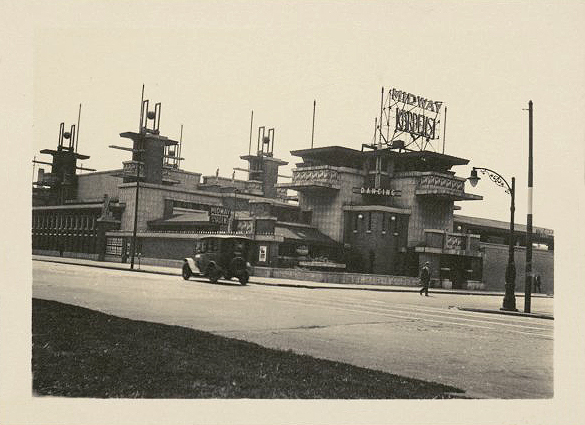 |
|
5) Looking Southwest
to the corner of Cottage Grove Avenue and Sixtieth. The
Winter Garden is on the left, North Belvedere in the center
and the North Arcade on the right. Spheres have been added
to the tops of the towers, as well as large signs. Large
Robie House styled vase can be seen on the corner. Two also
appeared on either side of the Stage. The are different then
the ones that appeared in the Summer Garden. |
|
|
|
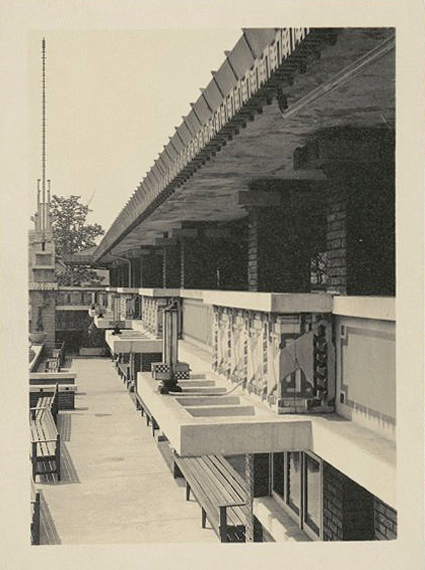 |
|
6)
North Arcade, looking West from the East end of the Arcade.
Four cantilevered trellised overhangs are visible, lamps
have been placed on them. Benches have replaced tables. |
|
|
|
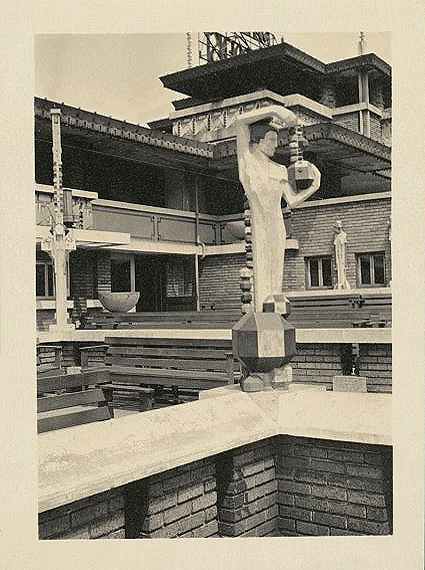 |
|
7) Looking Northeast
from the Summer Garden, the North Arcade is on the left, the
North Belvedere is to the right. This male Sprite holding
octagon was originally placed in the Northeast corner of the
Winter Garden. I believe this is the Northeast corner of the
interior terrace wall. Like the balconies in the background
and many other Sprites, this one was also painted. |
|
|
|
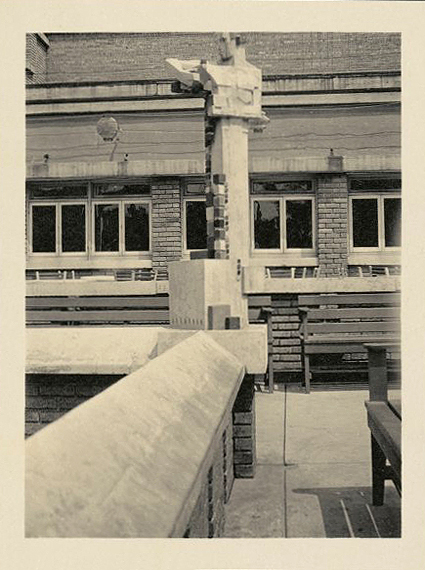 |
|
8) Male Sprite
holding cubes was originally placed in the Southwest corner
of the Winter Garden. I believe this is the Southeast corner
of the interior terrace wall. Like the balconies and many
other Sprites, this one was also painted. |
|
|
|
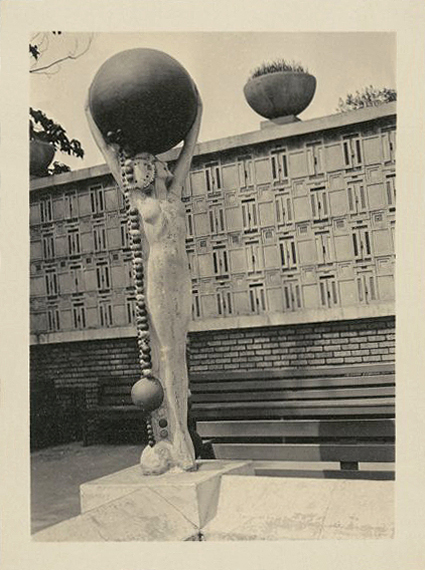 |
|
9) Female Sprite
holding sphere was originally placed in the Southeast corner
of the Winter Garden. This is the West end of the interior
terrace wall. Like many other Sprites, this one was also
painted. |
|
|
|
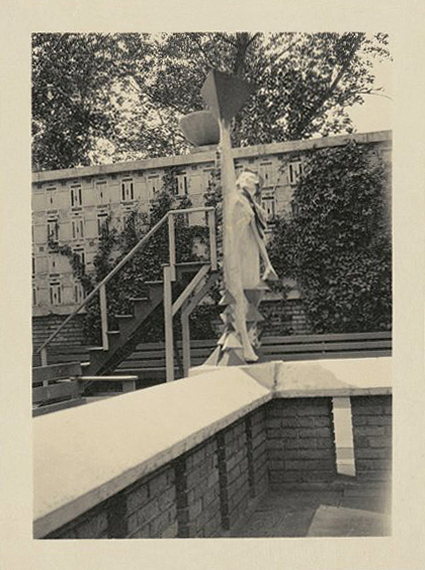 |
|
10) Female Sprite
holding triangle was originally placed in the Northwest
corner of the Winter Garden. This is the West end of the
interior terrace wall. Like many other Sprites, this one was
also painted. |
|
|
|
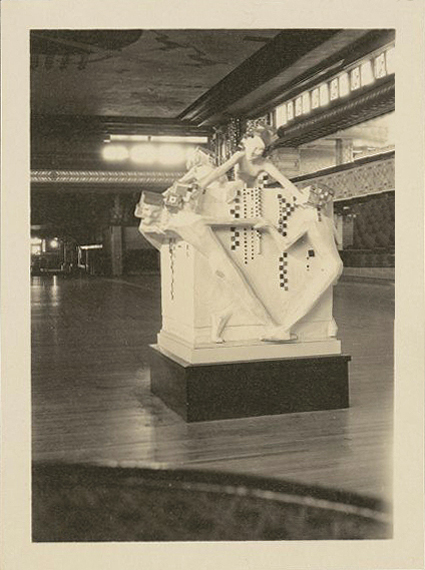 |
|
11)
This may be the most important image in this set. In Kruty’s
“Frank Lloyd Wright and Midway Gardens”, page 136 he states
that “Although no known photographs show the promenade’s
interior and, thus, the site of either fountain, it is
possible to get some idea of their forms from drawings and
fragments.” This may be the only image of the fountain that
exists. |
|
|
|
|
|
NATIONAL LIBRARY OF
AUSTRALIA
Eric Milton Nicholls collection.
Series of 11 images of
architect, Frank Lloyd Wright's Midway Gardens, Chicago.
Photograph possibly
taken by Walter Burley and Marion Mahony Griffin.
Photographed
between 1924-1926.
|
|
|
|
|
|
|
|
|
|
|
MIDWAY GARDENS ART GLASS WINDOW |
|
|
|
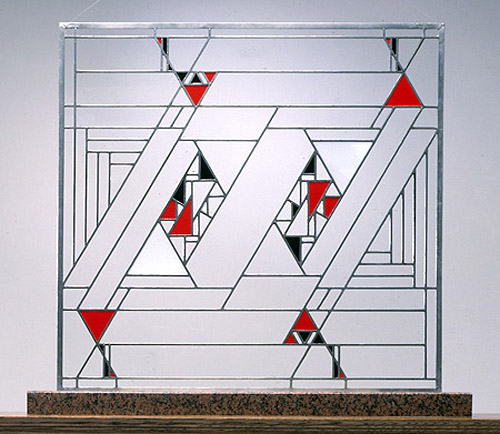 |
|
Midway Gardens
Art Glass window designed by Frank Lloyd Wright. Reproductions
available through Oakbrook Esser Studios. |
| |
|
|
|
|
|
|
MIDWAY GARDENS TIMELINE |
|
|
| 1913 |
Wright begins
designing Midway Gardens |
|
June 27th, 1914 |
Midway
Gardens officially opened |
|
September 1914 |
Henry
Fuermann & Sons photographs Midway Gardens |
|
May 31, 1916 |
Midway
Gardens was sold to the Edelweiss Brewery, renamed
Edelweiss Gardens |
|
1920 |
Prohibition was declared |
|
August 31, 1921 |
Sold to
E. C. Dietrich Midway Automobile Tire and Supply
Company and became the "Midway Dancing Gardens" |
|
October of 1923 |
Winter
Garden was revised and enlarged by removing
balconies |
|
1924 |
Benny Goodman plays at Midway
Gardens |
|
1925 |
Gilman Lane photographs Midway Dancing
Gardens |
|
Spring of 1929 |
Building leased to its final owner, Sinclair Filling
Station & Car Wash |
|
October 1929 |
Demolition of Midway Gardens begins |
| |
|
| |
Dates from “Frank Lloyd Wright and
Midway Gardens”, Kurty,1998 |
|
| |
|
|
|
|
|
|
|
|
|



